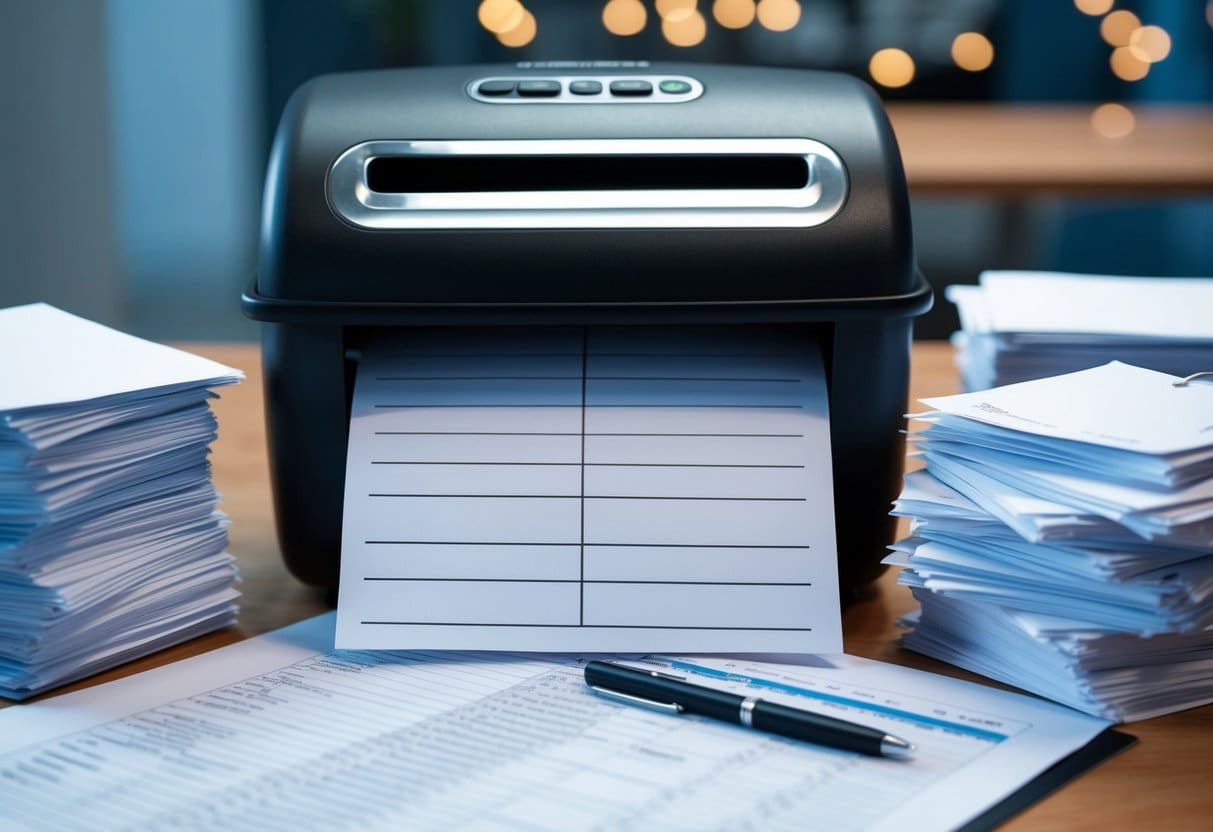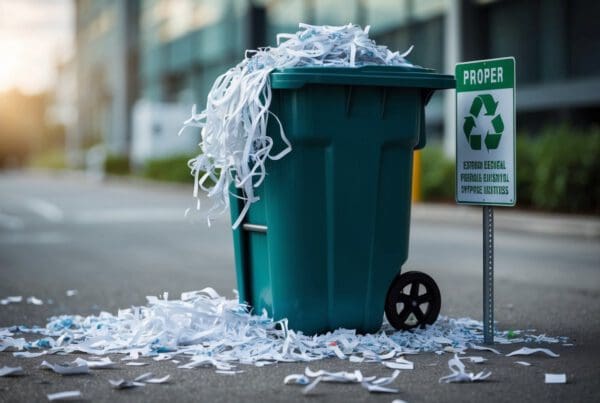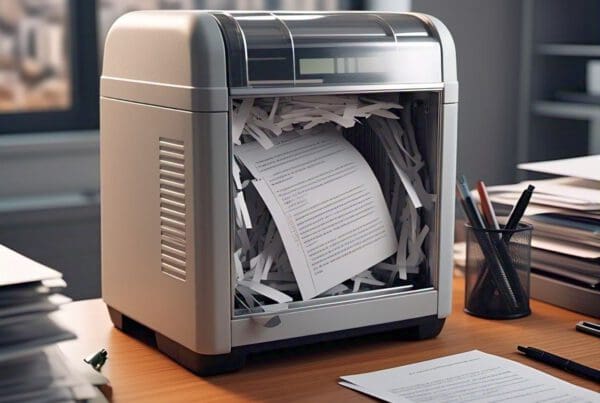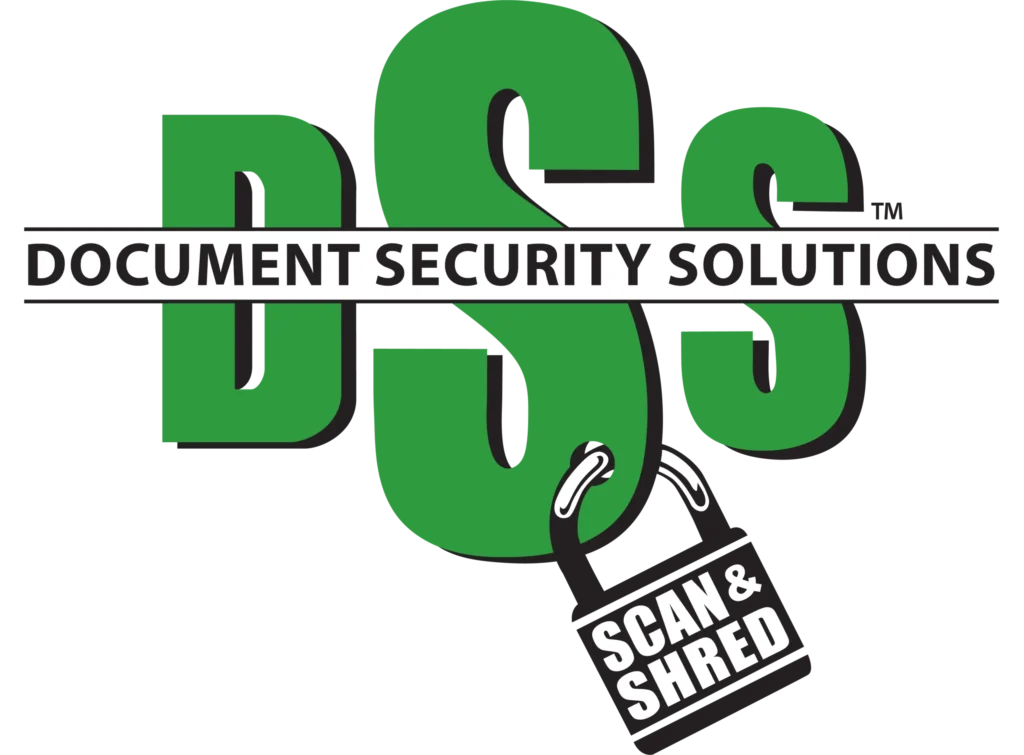Understanding Document Destruction and Compliance
In today’s businesses, understanding how to securely destroy documents is crucial. We must adhere to compliance standards and legal requirements to prevent data breaches and protect sensitive information. This involves protecting against identity theft and maintaining data privacy.
Importance of Data Security
Data security is critical in protecting sensitive information. By ensuring strong document destruction practices, we minimize the risk of data breaches and identity theft. Our secure processes protect client and company information.
We use methods like shredding and secure digital wiping. This helps maintain confidentiality, prevents fraud, and safeguards against compliance violations.
Legal Requirements for Document Destruction
Legal requirements are strict when it comes to document destruction. Regulations such as HIPAA, GLBA, and GDPR outline specific guidelines. We must comply to avoid penalties and ensure data protection.
For example, HIPAA focuses on health information security, while FACTA addresses consumer data. Each law targets different areas, but all emphasize the critical need for secure document disposal.
Document Destruction Laws and Policies
Policies on document destruction are shaped by laws and organizational standards. Compliance with these regulations, like NAID certifications, ensures we follow best practices. Non-compliance risks include legal action and reputation damage.
Adhering to privacy laws preserves data security. We must implement and regularly review our policies, ensuring they meet legal compliance and protect against unauthorized access.
Selecting the Right Document Destruction Services
Finding the best document destruction service involves choosing between on-site and off-site shredding, understanding certifications, and selecting the right shredders and disposal methods. We need to ensure the safety and confidentiality of our sensitive documents.
On-Site vs Off-Site Shredding
When it comes to on-site shredding, a mobile shredding truck comes to our location. This means we can watch the shredding process, which offers peace of mind. It’s especially good for businesses with a lot of sensitive documents.
Off-site shredding involves taking documents to another location. This can be more cost-effective and is often used by those with fewer documents. The materials are shredded in a secure facility, and we usually get a certificate of destruction.
Both on-site and off-site shredding ensure documents are safely destroyed, but the choice depends on our needs, budget, and comfort with risk.
Professional Shredding Services and Certifications
Using professional shredding services ensures that our sensitive documents are handled properly. These services often have strict security protocols. They might offer different options like cross-cut shredders or micro-cut shredders that provide different levels of security.
It’s important to look for AAA certification. This shows the service meets high security and confidentiality standards. A certificate of destruction is often provided, serving as proof that the shredding was completed correctly.
Choosing a service with the right certifications helps us ensure proper document destruction and maintain compliance with relevant laws.
Choosing Shredders and Secure Disposal Methods
Selecting the right shredders depends on the level of security we need. Strip-cut shredders cut paper into long strips and offer the least security. Cross-cut shredders make smaller pieces, providing better security. Micro-cut shredders offer the highest level of security by turning paper into tiny bits.
For secure disposal methods, pulverizing might be used for highly sensitive documents. Professional services also ensure that the shredded material is recycled, helping us stay environmentally responsible.
When choosing shredders and methods, it’s crucial to match the security level to our document destruction needs.
Building a Secure Document Handling Policy

To ensure the safety and confidentiality of business documents, it’s crucial to create a robust document handling policy. This includes developing stringent retention and destruction protocols, conducting regular audits, and enhancing employee awareness through training.
Developing Document Retention and Destruction Protocols
We need to establish clear document retention policies that outline how long records should be kept. This depends on factors like compliance requirements and business needs. Once documents are no longer needed, a documented destruction policy should dictate secure disposal methods.
Using certificates of destruction is a good practice to verify proper disposal has occurred. This protects against unauthorized access and supports risk management efforts by ensuring sensitive data is not improperly handled.
Regular Audits and Continuous Improvement
Regular audits help us identify gaps in our current practices and verify compliance with retention and destruction policies. Audits should examine if protocols are followed and recommend necessary changes for improvement.
Setting up a continuous improvement process ensures that our policies evolve with new technologies and regulations. This involves updating our guidelines and training programs to keep pace with changes, fostering a culture of accountability and security.
Employee Training and Awareness
Effective employee training programs are essential for a secure document handling policy. Our staff must be aware of company protocols and understand the importance of compliance. Training should cover correct document handling, storage, and destruction practices.
We can use workshops and online modules to make training engaging and informative. This will ensure employees remain vigilant and proactive in protecting sensitive information, supporting overall risk management and data security efforts.
Mitigating Risks Associated with Document Destruction
Document destruction is crucial for protecting sensitive information. We must be careful about compliance and safety to guard against legal issues and data breaches. By focusing on secure storage, regular shredding, and awareness of potential consequences, we can effectively manage the risks associated with document destruction.
Consequences of Non-Compliance and Data Breaches
Failing to properly destroy documents can lead to severe legal penalties and reputational damage. When customer information, employee records, or medical records are compromised, it harms our trust with clients. Data breaches expose us to lawsuits and fines that can cripple small businesses and large corporations alike.
We need to follow legal requirements for disposing of confidential data. Non-compliance can result in costly penalties. Therefore, it’s essential to ensure that document destruction processes align with legal standards.
Secure Storage and Handling of Confidential Documents
Secure storage is vital before destruction takes place. Confidential documents, such as legal papers or customer information, should be stored in locked cabinets or secure digital formats.
Access must be limited to authorized personnel to prevent unauthorized handling. We can use training programs to educate employees on the significance of secure document handling. This ensures that sensitive information remains safe from the time it is created until it is destroyed.
Creating a Regular Shredding Schedule
Regular shredding is a key step in safeguarding confidential data. By setting up a shredding schedule, we can ensure that documents are destroyed consistently. This reduces the risk of sensitive information lingering beyond its necessary lifespan.
Establishing a timetable for shredding helps keep our process organized. We should evaluate our document volumes to decide if weekly, monthly, or quarterly shredding is needed. A systematic approach reinforces our commitment to data protection and compliance.
Understanding the Recycling Process and Secure Document Destruction
When we think about recycling, it’s about turning old paper into new products. Recycling helps us save resources by reusing paper. But, it’s crucial to consider how we dispose of documents that might have sensitive information. This is where secure document destruction comes into play.
Secure document destruction ensures that sensitive files can’t be accessed by unauthorized individuals. It aligns with data protection laws, keeping our data safe. This is important for maintaining trust and avoiding any legal issues. One common method for this is document shredding services.
We can use professional document shredding services for secure disposal. These services handle large volumes efficiently and offer security guarantees. They cut our documents into small pieces, making it impossible to piece them back together. Some companies also provide locked bins for added security until pickup.
Staying compliant with data protection laws is vital. These laws require us to protect personal information. Through secure document destruction, we minimize risks related to data breaches. It is a step we take to uphold our privacy commitments and maintain business integrity.





